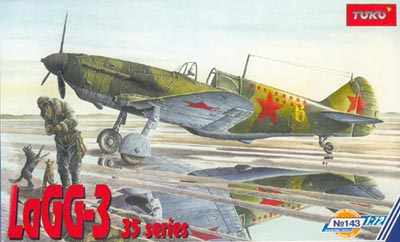
In origin, Toko produced one kit only, then it was replaced in the catalogue by three kits relative to different versions, containing different decals sheets but the same pieces.
|
all versions are allowed by Massimo Tessitori |
|
|
 |
The most noticeable characteristic of the kit of LaGG-3 made by the
Ukrainan firm Toko (later Roden) is the wide choice of alternative parts
that allow to reralize nearly all the versions with very little adaptation
work.
In origin, Toko produced one kit only, then it was replaced in the catalogue by three kits relative to different versions, containing different decals sheets but the same pieces. |
The kit of series 35 has decals for :
|
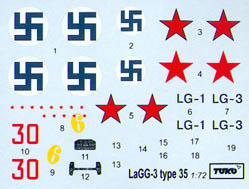 |
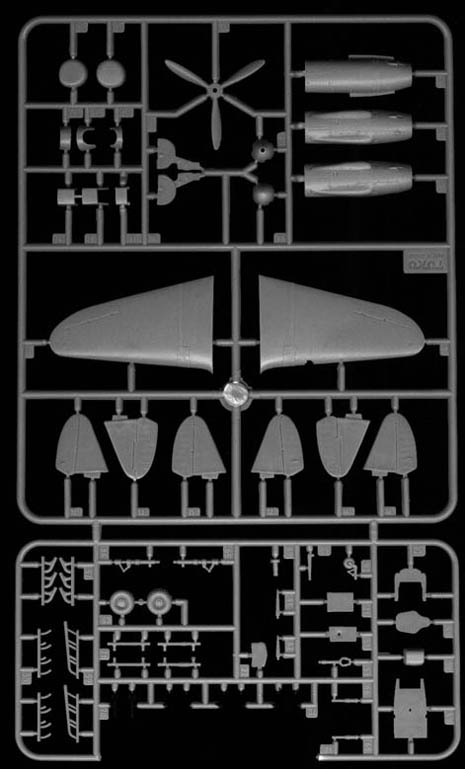
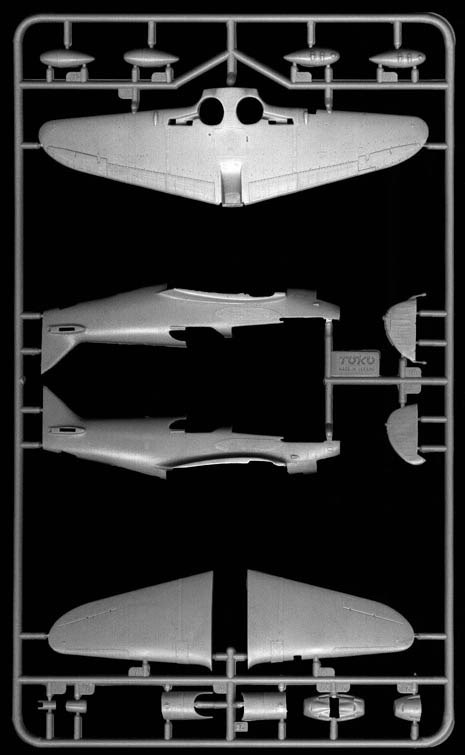 |
The pieces are neatly moulded in light grey plastic.
There are fine recessed panels and rivets, plus some overposition panels; all this is more realistic than the usual stereotyped entirely recessed panel lines that are standard on most kits. A wide part of the aircraft was made by Alpha wood, so these surfaces are without panel lines. The reproduction of fabric covered surfaces is good. The details of the cockpit interior are fairly good, including an instrument panel with two decals, a two-piece seat (which rear plate should be thinned and its sides should be bent forward), a detailed floor, a too large control column, side details and a radio deck. The main undercarrage is composed by fine doors, legs, actuators and fair wheels (but with a too narrow center disk; it could be replaced by one advanced from a Eduard La-7); the bays are rightly deep and their details (or lack of details) corresponds well to that of the real subject. The outlet flaps of the coolers should be thinned on the internal side. A wide choice of alternative parts is provided:
|
The fuselage halves are nearly perfect for series 11, but require some
modifies for reproducing other models.
For earlier series, the modifies required on fuselage halves
are:
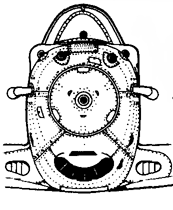 |
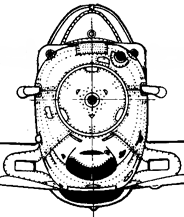 |
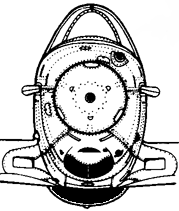 |
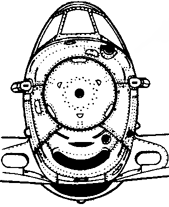 |
| front of series 1, with oval wingroot intakes, five guns, one-piece exhaust stacks, oil cooler intake of first type, dzud locks on lower cowling panel. | front of series 4, with reptangular wingroot intakes, four guns, one-piece exhaust stacks, oil cooler intake of second type, fast locks on lower cowling panel. | front of series 35, with reptangular wingroot intakes, two guns, three-pieces exhaust stacks, oil cooler intake of second type, fast locks on lower cowling panel, side panels divided in two pieces, large ventral water cooler intake. | front of series 66, with oval wingroot intakes, two guns, six-pieces exhaust stacks, oil cooler intake of third type, fast locks on lower cowling panel. |
| The kit provides two canopies, one (piece 42) for series 60-70 only,
the other one (piece 43) for all series before 60 (66 in particular).
They are fairly good, but both windshields are a bit thick and too low, being their front/side edge cut too back; the front flat panel is too small, it can be a bit enlarged by deleting its frames and repainting them on a more external position. Besides, we see that the piece 42 is longer than 43, because (in series 66) the sliding part was partially overposed to the rear fuselage; this will require some arrangement; here are some possibilities:
|
 |
One could try to resume in one table the pieces to use for each version
and the eventual modifies that could be necessary.
The evolution of LaGG-3 during its production was gradual, and different
series built in different factories at the same time could differ in details.
| I-301
prototype |
series 1 | series 4 | series 8 | series 11 | series 23 | series 29 | series 33 | series 34
(heavy gun) |
series 35 | series 66 | |
| June 1940 | early 1941 | summer 1941 | late 1941 | early 1942 | summer 1942 | summer 1942 | late 1942 | 1943/44 | |||
| engine cowling | 4 (remove bulges for very first config.) | 4 | 5 | 3 (without fast locks) | 3 (with fast locks) | 3 (with fast locks) | 3 (with fast locks) | 3 (with fast locks) | 3 (with fast locks) | 3 (with fast locks) | 3 (with fast locks) |
| oil cooler intake and outlet flap | 30-27-33 | 30-27-33 | 31-28-33 | 31-28-33 | 31-28-33 | 31-28-33 | 31-28-33 | 31-28-33 | 31-28-33 | 31-28-33 | 32-29-33 |
| cowling sides intakes | wide with some slots | as on kit | as on kit | only holes | as on kit | as on kit | as on kit | as on kit | as on kit | revised panelling | |
| exhaust stacks | 65 | 65 | 65 | 65 | 65 | 65 | 57 | 57 | 57 | 57 | 55 |
| side plates behind exhausts | none | rounded with a slot on the left side | as on kit | as on kit | as on kit | as on kit | none | none | none | none | none |
| spinner | 40 | 40 | 40 | 40 | 40 | 40 | 40 | 39 | 39 | 39 | 39 |
| prop shaft gun | 12,7 mm | 12,7 mm | 20 mm | 20 mm or 23 mm | 20 mm | 20 mm | 20 mm | 20 mm | 37 mm | 20 mm | 20 mm |
| supercharger intakes |
oval |
oval | rectangular | rectangular | rectangular | rectangular | rectangular | rectangular | recptangular | rectangular | oval (wide ) |
| water cooler tunnel intake | 19 | 19 | 19 | 19 | 19 | 19 | 19 | 19 | 19 | 20 | 19 |
| water tunnel outlet flap | 24 | 24 | 24 | 24 | 24 | 24 | 24 | 24 | 24 | 24 | 24 |
| water tunnel outlet step | large | small | small | small | none | none | none | none | none | none | none |
| tail wheel doors | 35 | 35 | 35 | 35 | 35 | 35 | 35 | 35 | 35 | 36 | 36 |
| rudder | 18 | 18 | 18 | 18 | 18 | 17 | 17 | 17 | 17 | 17 | 17 |
| rudder balances | none | both | only up | only up | only up | none | none | none | none | none | none |
| antenna mast | none | 62 | 61 | 61 | 61 | 61 | 61 | 61 | 61 | 61 | 62 |
| tail horizontal plans | 11+12 | 11+12 | 11+12 | 15+16 | 15+16 | 15+16 | 15+16 | 15+16 | 15+16 | 13+14 | 13+14 |
| wings | 9+10 | 9+10 | 9+10 | 9+10 | 9+10 | 9+10 | 9+10 | 9+10 | 9+10 | 7+8 | 7+8 |
| pitot probe | leading edge | leading edge | leading edge | leading edge | leading edge | leading edge | leading edge | leading edge | leading edge | undersurface | undersurface |
| landing light | none | one | one | one | one | one | one | one | one | one | none |
| canopy | 43 | 43 | 43 | 43 | 43 | 43 | 43 | 43 | 43 | 43 | 42 |
|
|